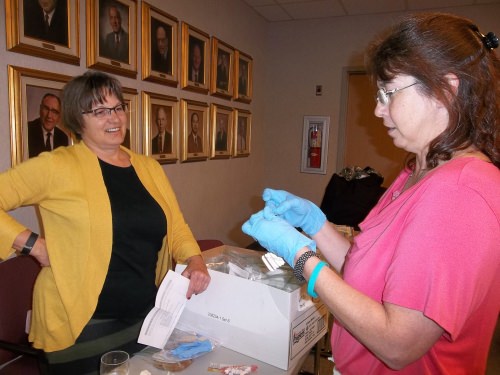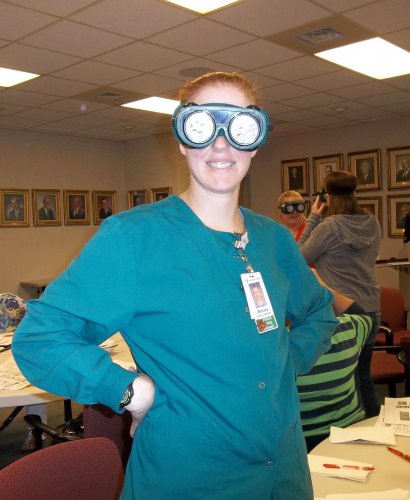UW connects caregivers with research, tools to help older adults
The University of Wisconsin–Madison School of Nursing is reaching out to home health aides and others who care for older adults across Wisconsin to share the latest research and evidence-based best practices to promote health and well-being.
The school’s Center for Aging Research and Education (CARE) recently held its third annual conference at Monroe Clinic. The free event was open to home health aides, certified nursing assistants (CNAs), personal care workers, resident assistants and other direct care workers.
“I feel very lucky to have attended and can’t wait to take what I’ve learned and apply it to my residents,” said Traci Bach, a CNA from Cuba City who works with people living with dementia.

Assistant Professor Barb King (left) leads Cuba City CNA Traci Bach through an exercise. Photo: Center for Aging Research and Education
Direct care workers meet the daily needs of older adults in nursing homes, assisted living facilities and continuing care retirement communities and greatly impact the care provided by hospitals and home health agencies. Yet most have limited access to educational opportunities. The CARE conference is changing that, sharing current research to help workers understand complex conditions and best care practices.
At the June 13 conference, more than 60 direct care workers from across Wisconsin heard from nurse researchers and experts about maintaining older adult mobility; understanding what’s normal and what’s not about vision changes with age; responding to dementia-related behavioral symptoms; and managing their own stress to avoid burnout.
The presenters acknowledged the important role that direct care workers play.
“It’s all about you guys. It’s all about what you do,” said Assistant Professor Barb King.
King’s research focuses on older adults’ functional decline during hospitalization. She explained that older adults start losing muscle mass after only two days of bed rest. It can take a month to reverse those physiological changes.
King’s presentation inspired several conference attendees to take action. One CNA who works in a nursing home said she hopes to use the information to develop more physical activity for her residents. A resident assistant said she plans to propose that the assisted living facility where she works begin offering walking aides to support residents.

Brooke Foley of Monroe and other participants tried to perform simple tasks wearing low-vision goggles that simulate the effects of vision problems. Photo: Center for Aging Research and Education
Assistant nursing Professor Andrea Gilmore-Bykovskyi explained how dementia-related behavioral symptoms — such as wandering, calling out, agitation or refusing care — are often attempts to communicate unmet needs.
People living with dementia may be less able to communicate their needs directly, especially as the disease progresses. To identify and address their needs, Gilmore-Bykovskyi described a simple approach. Caregivers examine a dementia-related behavior, and consider the conditions or actions prior to the behavior and the consequences.
“CNAs are by far the most important people” in figuring out the unmet needs of people living with dementia, Gilmore-Bykovskyi said. “You have sufficient contact with the person to recognize patterns. You know what’s happening, how often, and what happens before or after that. In fact, CNAs are likely the only people to have all that information.”
One participant said the most useful thing she learned was how to “put myself in patients’ shoes, especially people with impairments and those living with dementia.” Another said she learned how to “be a voice for my residents that don’t have one.”
In addition to the presentations, attendees learned from hands-on exercises. In one, they put on low-vision goggles that simulate the effects of macular degeneration, glaucoma, cataracts and other vision problems. They then tried to perform simple tasks. Another exercise used a simple kit to illustrate the sensory changes that accompany normal aging.
King’s presentation inspired several conference attendees to propose more physical activity for nursing home residents, and walking aides in an assisted living facility.
One hospital CNA held a piece of yellow cellophane up to her eyes to simulate changes in the aging lens. She found she could no longer distinguish the colors of small objects before her.
“Now imagine if I tell you to take the green pill when you get up in the morning,” said King. “Oh, no!” one exclaimed.
The participants all said they would recommend the CARE conference to others.
As a health care provider, Monroe Clinic understands the importance of professional development for direct care staff, said Tammie Evenstad, the clinic’s community outreach specialist.
“We were pleased to have the opportunity to host the conference,” she said. “Quality educational events like this benefit everyone in the communities we serve.”
For more information on CARE and future conferences, visit the center’s website, call 608-265-4330 or email care@son.wisc.edu.
Subscribe to Wisconsin Ideas
Want more stories of the Wisconsin Idea in action? Sign-up for our monthly e-newsletter highlighting how Badgers are taking their education and research beyond the boundaries of the classroom to improve lives.
Tags: health care, nursing, outreach, The Wisconsin Idea




